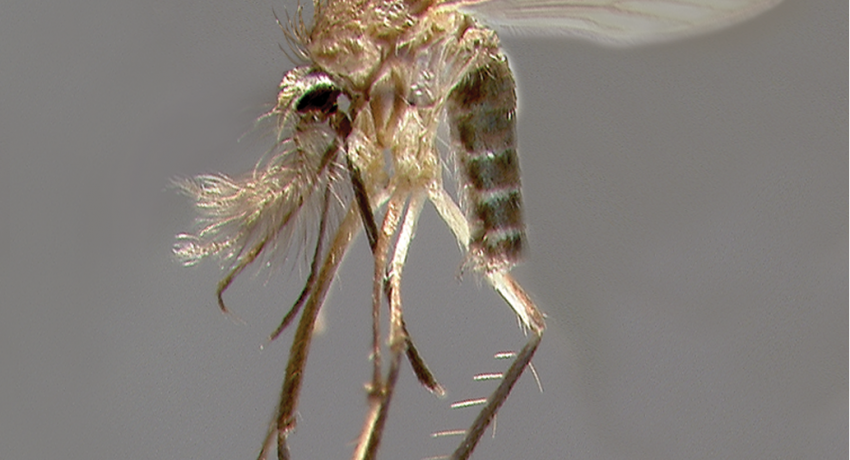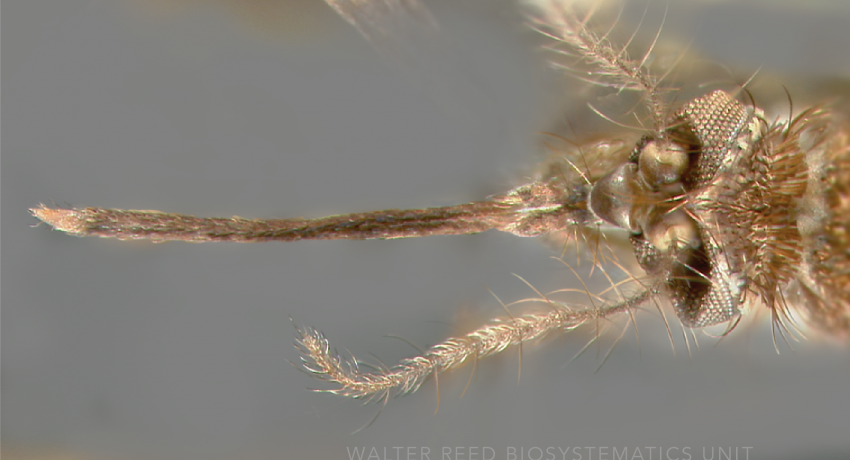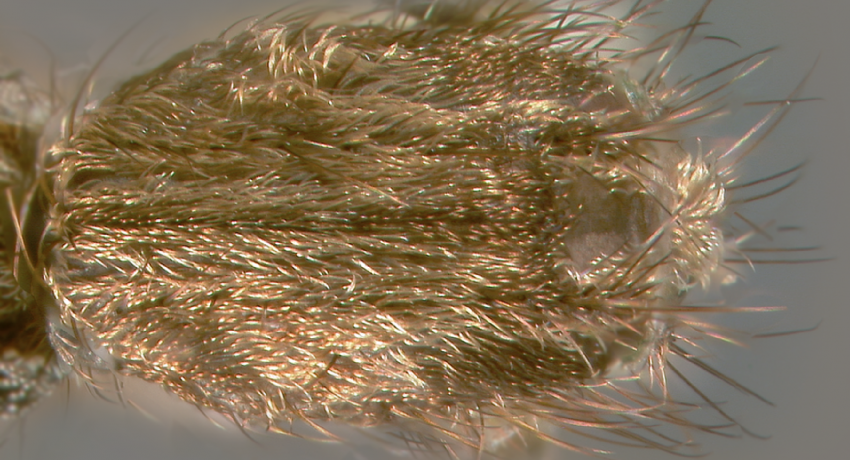NEOTROPICAL & NEARCTIC REGIONS
Etymology: erratic (L); refers to comb scales in irregular row
Culex erraticus is a common species across its range. It the nominotypical member of both the Erraticus Group and Erraticus Subgroup. The Erraticus Subgroup comprises three species: Cx. erraticus, Cx. aureonotatus Duret & Barreto and Cx. invocator Pazos.
Type locality: Baton Rouge, Louisiana, United States
Type depository: U.S. National Museum, Washington, D.C., United States (USNM)
DIAGNOSTIC CHARACTERS (Click photos to view; mouse over and click large photo to zoom in.)
ADULT (illustrated): Head: Vertex with narrow decumbant scales centrally eyes nearly encircled by broad scales. Thorax: Acrostichal setae absent; mesepimeron with patch of large scales. Legs: Ta-I–III all dark (both sexes). Wing: Veins R2, R3 with broad plume scales.
LARVA (not illustrated): Terminal segments: Comb scales long, with pointed, unfringed apical section; saddle with sharp spicules on margin.
TAXONOMIC KEYS
Carpenter & LaCasse 1955
Dodge 1966
Darsie & Ward 2005
Harrison et al. 2016
![]()
WRBU – Culex (Mel.) - Neotropical Region – Larva
Exemplar DNA sequences
Cx. erraticus COI: KM593023–24, KM593029, KM593031–32, KM593041, KM593045, KT766417, KT766418–31, KX389310, KY859873–84
BIONOMICS
Immatures
Typical immature habitats for Cx. erraticus include the shaded edges of large, heavily vegetated swamps, dams, lakes, and slow-moving rivers in Panama. In Venezuela, Cx. erraticus were found with unshaded, warm, vegetated waters in flooded open pastures and swamps. Females deposit their eggs as small masses glued to the surfaces of floating leaves or vegetation in these habitats.
Adults
Host choice in Cx. erraticus linked to avian breeding cycles. In the spring, female Cx. erraticus feed almost exclusively on nesting birds and hatchlings. As the hatchlings leave the nests, Cx. erraticus will feed on mammals—dogs, white-tailed deer, cats, horses, and people—and reptiles, amphibians and wading birds, including the great blue and yellow-crowned night herons. Culex erraticus is a proven vector of the lizard malaria, Plasmodium floridense.
DISTRIBUTION NOTES
Bahamas, Belize, Brazil, Canada, Colombia, Costa Rica, Cuba, Curacao, Dominican Republic, Ecuador, El Salvador, French Guiana, Guatemala, Guyana, Haiti, Honduras, Jamaica, Mexico, Nicaragua, Panama, Paraguay, Peru, Puerto Rico, Suriname, Trinidad & Tobago, United States (continental), Venezuela, Virgin Islands.

WRBU VECTOR HAZARD REPORTS
VHR: Mosquitoes of the Caribbean
View other WRBU Vector Hazard Reports
Available GIS Models:
None
IMPORTANT REFERENCES (full citations below)
Dyar & Knab 1906d: 224 (L*; Mochlostyrax)
Howard et al. 1913 (1912): Figs. 349, 588, 689 (L*, E*)
Howard et al. 1913 (1912): Figs. 72, 363, 588, (M*, L*; as trachycampa)
Howard et al. 1913 (1912): Figs. 84, 353 (M*, L*; as leprincei)
Howard et al. 1915: 397 (M, F, L; as leprincei)
Howard et al. 1915: 329 (M, F, L; as trachycampa)
Dyar 1923e (taxonomy; as leprincei)
Dyar 1928: 299 (M*, F, L*; M*; in part; as abominator)
King & Bradley 1937: 345 (M*, L*; taxonomy)
Rozeboom 1942b: 40 (M*, F, L)
Michener 1944: 263 (F*)
Carpenter et al. 1946: 262 (M*)
Ross 1947 (F*)
Rozeboom & Komp 1950a: 91 (M*)
Yamaguti & LaCasse 1951c: 87 (M*, F*, L*)
Lane 1953: 492 (M*, F, L*)
Foote 1954: 51 (P*, L*; distribution; Brazil, Cuba, Honduras, Mexico, Nicaragua,)
van der Kuyp 1954: 39 (M, F, L*; bionomics)
Carpenter & LaCasse 1955: 305 (M*, F*, L*; keys)
Stone & Knight 1957a: 49 (lectotype designation)
Stone et al. 1959: 270 (distribution; Dominican Republic)
Cova García et al. 1966: 197 (M*)
Dodge 1966: 369 (1st instar L*; key)
Duret 1969a (distribution; Paraguay)
Belkin et al. 1970: 84 (M*, F, P*, L*)
Bertram 1971: 745 (distribution; Belize)
Knight & Haeger 1971: 553 (F*; taxonomy)
Panday 1975a,b (distribution; Suriname)
Mattingly 1976: 226 (E*)
Heinemann & Belkin 1977b: 428, 433, (distribution; Guatemala, El Salvador)
Sirivanakarn 1978a: 244 (M*)
Sirivanakarn 1983: 279 (M*, F*)
Townsend 1990: 143 (type information)
Pecor et al. 1992: 26 (M*; taxonomy, catalog citation)
Darsie & Ward 2005 (F*, L*; keys, distribution)
Mendenhall et al. 2012 (molecular taxonomy)
Torres-Gutierrez & Sallum 2015: 18 (taxonomy, bionomics, distribution; catalog citation)
Harrison et al. 2016 (F*, L*; keys, distribution)
Giordano 2019 (distribution; Canada)
CURRENT SYNONYMS
syn. leprincei Dyar & Knab
1907c: 202 (M, F). Type location: Tabernilla, Canal Zone, Panama (USNM). References: King & Bradley 1937: 346 (synonymy); Stone & Knight 1957a: 52 (lectotype designation).
syn. egberti Dyar & Knab
1907d: 214 (F). Type location: Warner's Camp, Lake Okeechobee, Florida, United States (USNM). References: King & Bradley 1937: 345 (synonymy); Stone & Knight 1957a: 48 (lectotype designation).
syn. trachycampa Dyar & Knab
1909c: 101 (M, P). Type location: Las Cascadas, Canal Zone, Panama (USNM). References: Dyar 1918b: 105 (synonomy with leprincei); King & Bradley 1937: 346 (taxonomy); Stone & Knight 1957a: 57 (lectotype designation).
syn. peribleptus Dyar & Knab
1918 (1917)c: 181 (M, F). Type location: Parr Shoals, South Carolina, United States (USNM). References: Dyar 1920l: 161 (L); King & Bradley 1937: 346 (syn.); Stone & Knight 1957a: 54 (lectotype designation).
syn. pose Dyar & Knab
1918 (1917)c: 182 (F). Type location: Dallas, Texas, United States (USNM). References: King & Bradley 1937: 346 (synonymy); Stone & Knight 1957a: 53 (lectotype designation).
syn. moorei Dyar
1918b: 108 (F). Type location: Plantation Plaisance, Georgetown [Demerara], British Guiana [Guyana] (USNM). References: King & Bradley 1937: 346 (synonymy); Stone & Knight 1957a: 53 (lectotype designation).
syn. degustator Dyar
1921c: 39 (M). Type location: Scott, Arkansas, United States (USNM). References: King & Bradley 1937: 346 (synonymy); Stone & Knight 1957a: 47 (lectotype designation).
syn. homoeopas Dyar & Ludlow
1921a: 46 (M). Type location: Jackson Barracks, New Orleans, Louisiana, United States (USNM). References: King & Bradley 1937: 346 (synonymy).
syn. borinqueni Root
1922b: 400 (M*, F, L*). Type location: Rio Piedras, [San Juan], Puerto Rico (USNM). References: King & Bradley 1937: 346 (synonymy); Stone & Knight 1957a: 44 (lectotype designation).
syn. tovari Evans
1924: 367 (M*). Type location: Palo Negro, Venezuela (NHMUK). References: King & Bradley 1937: 346 (synonymy); Belkin 1968b: 21 (type information); Townsend 1990: 143 (type information).
CITED REFERENCES
Belkin, J.N. (1968b). Mosquito studies (Diptera, Culicidae). IX. The type specimens of New World mosquitoes in European museums. Contributions of the American Entomological Institute, 3(4), 1–69.
Belkin, J.N., Heinemann, S.J., & Page, W.A. (1970). The Culicidae of Jamaica (Mosquito studies. XXI) Contributions of the American Entomological Institute, 6(1), 458.
Bertram, D.S. (1971). Mosquitoes of British Honduras, with some comments on malaria, and on arbovirus antibodies in man and equines. Transactions of the Royal Society of Tropical Medicine and Hygiene, 65(6), 742–762.
Carpenter, S J., Middlekauff, W.W., & Chamberlain, R.W. (1946). The mosquitoes of the southern United States; east of Oklahoma and Texas. Notre Dame, Indiana: The University Press.
Carpenter, S.J., & LaCasse, W.J. (1955). Mosquitoes of North America (North of Mexico). Berkeley, Los Angeles: University of California Press.
Cova García, P., Sutil, E., & Rausseo, J.A. (1966). Mosquitos (Culicinos) de Venezuela (Vol. II). Caracas: Ministerio de Sanidad y Asistencia Social, Caracas.
Darsie, R.F., Jr., & Ward, R.A. (2005). Identification and geographical distribution of the mosquitoes of North America, north of Mexico. Gainesville, FL: University Press of Florida.
Dodge, H. R. (1966). Studies on mosquito larvae II. The first-stage larvae of North American Culicidae and of world Anophelinae. Canadian Entomologist, 98, 337–393.
Duret, J.P. (1969a). Contribucion al conocimiento de los Culex del Paraguay (Diptera-Culicidae). Revista de la Sociedad Entomologica Argentina, 31, 3–13.
Dyar, H.G. (1918b). A revision of the American species of Culex on the male genitalia. Insecutor Inscitiae Menstruus, 86–111.
Dyar, H.G. (1920l). Descriptions of hitherto unknown larvae of Culex (Diptera, Culicidae). Insecutor Inscitiae Menstruus, 7(10–12), 161–162.
Dyar, H.G. (1921c). Notes on the North American species of Choeroporpa (Diptera, Culicidae). Insecutor Inscitiae Menstruus, 9, 37–39.
Dyar, H.G. (1923e). On some of the American subgenera of Culex (Diptera, Culicidae). Insecutor Inscitiae Menstruus, 11, 187–190.
Dyar, H.G. (1928). The mosquitoes of the Americas. Washington, DC: Carnegie Institution of Washington.
Dyar, H.G., & Knab, F. (1906d). The larvae of Culicidae classified as independent organisms. Journal of the New York Entomological Society, 14, 169–230.
Dyar, H.G., & Knab, F. (1907c). Descriptions of new mosquitoes from the Panama Canal Zone. Journal of the New York Entomological Society, 15, 197–212
Dyar, H.G., & Knab, F. (1907d). Descriptions of three new North American mosquitoes. Journal of the New York Entomological Society, 15, 213–214.
Dyar, H.G., & Knab, F. (1909c). Mosquito comment. Canadian Entomologist, 41, 101–102.
Dyar, H.G., & Knab, F. (1918c). The genus Culex in the United States (Diptera, Culicidae). Insecutor Inscitiae Menstruus, 5 (1917), 170–183.
Dyar, H.G., & Ludlow, C.S. (1921a). Two new American mosquitoes (Diptera, Culicidae). Insecutor Inscitiae Menstruus, 9, 46–50.
Evans, A.M. (1924). Descriptions of new mosquitos from South America. Annals of Tropical Medicine and Parasitology, 18, 363–375.
Foote, R. H. (1954). The larvae and pupae of the mosquitoes belonging to the Culex subgenera Melanoconion and Mochlostyrax. Technical Bulletin, United States Department of Agriculture.
Giordano, B.V. (2019). Transmission dynamics and epidemiology of West Nile Virus in Ontario, Canada. PhD thesis, Brock University, Canada.
Harrison, B.A., Byrd, B.D., Sither, C.B., & Whitt, P.B. (2016). The mosquitoes of the Mid-Atlantic Region: an identification guide (Vol. 1). Madison Heights, MI: Publishing XPress.
Heinemann, S.J., & Belkin, J.N. (1977b). Collection records of the project Mosquitoes of Middle America 8. Central America: Belize (BH), Guatemala (GUA), El Salvador (SAL), Honduras (HON), Nicaragua (Nl, NIC). Mosquito Systematics, 9(4), 403–454.
Howard, L.O., Dyar, H.G. & Knab, F. 1915. The mosquitoes of North and Central America and the West Indies. Volume three. Systematic description (in two parts). Part I.. Públication No. 159. Carnegie Institution of Washington, Washington, D.C.
Howard, L.O., Dyar, H.G., & Knab, F. (1913). The mosquitoes of North and Central America and the West Indies. (Vol. II) (1912). Washington, D.C.: Carnegie Institution of Washington.
King, W.V., & Bradley, G.H. (1937). Notes on Culex erraticus and related species in the United States (Diptera, Culicidae). Annals of the Entomological Society of America, 30, 345–357.
Knight, J.W., & Haeger, J.S. (1971). Key to adults of the Culex subgenera Melanoconion and Mochlostyrax of Eastern North America. Journal of Medical Entomology, 18, 551–555.
Lane, J. (1953). Neotropical Culicidae (Vols. I, II). São Paulo: University of São Paulo.
Mattingly, P.F. (1976). Mosquito Eggs XXVIII. Culex subgenera Melanoconion and Mochlostyrax. Mosquito Systematics, 8(3), 223–231.
Mendenhall, I.H., Bahl, J., Blum, M.J., & Wesson, D.M. (2012). Genetic structure of Culex erraticus populations across the Americas. Journal of Medical Entomology, 49(3), 522–534.
Michener, C.D. (1944). Differentiation of females of certain species of Culex by the cibarial armature. Journal of the New York Entomological Society, 52, 263–266.
Panday, R.S. (1975a). Mosquito identification studies in a savanna forest in Surinam. Mosquito News, 35(2), 141–146.
Panday, R.S. (1975b). Mosquito identification studies in a typical coastal area in Northern Surinam. Mosquito News, 35(3), 297–301.
Pecor, J.E., Mallampalli, V.L., Harbach, R.E., & Peyton, E.L. (1992). Catalog and illustrated review of the subgenus Melanoconion of Culex (Diptera: Culicidae). Contributions of the American Entomological Institute, 27, 1–228.
Root, F.M. (1922b). Notes on mosquitoes and other blood-sucking flies from Porto Rico. American Journal of Hygiene, 2, 394–405.
Ross, H.H. (1947). The mosquitoes of Illinois (Diptera, Culicidae). Bulletin of the Illinois Natural History Survey, 24(1), 1–96.
Rozeboom, L.E. (1942b). The mosquitoes of Oklahoma. Technical Bulletin of the Oklahoma Agricultural Experiment Station.
Rozeboom, L.E., & Komp, W.H.W. (1950a). A review of the species of Culex of the subgenus Melanoconion (Diptera, Culicidae). Annals of the Entomological Society of America, 43, 75–114.
Sirivanakarn, S. (1978a). Revalidation of Culex (Melanoconion) invocator Pazos with a redescription of adults and illustration of male genitalia (Diptera: Culicidae). Mosquito Systematics, 10(2), 239–245.
Sirivanakarn, S. (1983). A review of the systematics and a proposed scheme of internal classification of the New World subgenus Melanoconion of Culex (Diptera: Culicidae). Mosquito Systematics, 14 (1982)(4), 265–333.
Stone, A., & Knight, K.L. (1957a). Type specimens of mosquitoes in the United States National Museum. IV: The genus Culex (Diptera, Culicidae). Journal of the Washington Academy of Sciences, 47(2), 42–59.
Stone, A., Knight, K.L., & Starcke, H. (1959). A synoptic catalog of the mosquitoes of the World (Diptera, Culicidae) (Vol. 6). Washington, D.C.: Entomological Society of America, The Thomas Say Foundation.
Torres-Gutierrez, C., & Sallum, M.A.M. (2015). Catalog of the subgenus Melanoconion of Culex (Diptera: Culicidae) for South America. Zootaxa, 4028(1), 1–50.
Townsend, B.C. (1990). Culicidae. In B.C. Townsend, J.E. Chainey, R.W. Crosskey, A.C. Pont, R.P. Lane, J.P.T. Boorman, & C.A. Crouch (Eds.), A catalogue of the types of bloodsucking flies in the British Museum (Natural History). London: British Museum (Natural History).
van der Kuyp, E. (1954). Mosquitoes of the Netherlands Antilles and their hygienic importance. Studies on the Fauna of Curacao and other Caribbean Islands, 5, 37–114.
Yamaguti, S., & LaCasse, W. J. (1951c). Mosquito fauna of North America. Part IV. Genera Culex and Deinocerites. Office of the Surgeon General, Headquarters, 8th Army, APO 343. United States. 207th Malaria Survey Detachment.
CITE THIS PAGE
Walter Reed Biosystematics Unit (Year). Culex erraticus species page. Walter Reed Biosystematics Unit Website, http://wrbu.si.edu/vectorspecies/mosquitoes/erraticus, accessed on [date (e.g. 03 February 2020) when you last viewed the site].











































































































































































